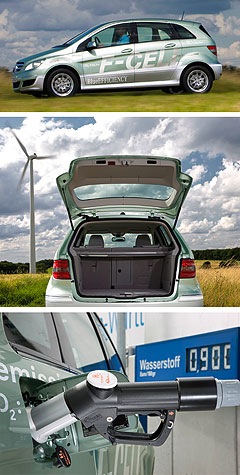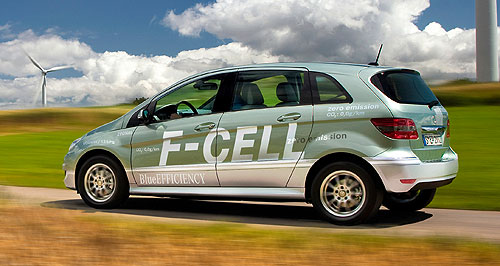Make / Model Search
Future models - Mercedes-Benz - B-Class - FCVMercedes fuel-cell B-class to hit US, Euro marketsHard cell: The Mercedes-Benz B-class F-Cell stores hydrogen gas under twice the pressure of previous models, giving greater range. Benz B-class F-Cell hydrogen-electric hybrid offers hot performance, zero emissions31 Aug 2009 By TERRY MARTIN MERCEDES-BENZ has launched its first series-production fuel-cell vehicle – the B-class F-Cell – ahead of an initial 200-unit production run in December and deliveries the following month to customers in Europe and the US, who will lease the zero-emissions eco car. The German manufacturer claims the hydrogen-electric hybrid offers similar performance to a conventional 2.0-litre petrol-engine car and consumes the equivalent of 3.3 litres of diesel per 100km (combined), based on the NEDC European standard. According to Mercedes, the B-class F-Cell features a new generation of its compact, high-performance fuel cell system, in which gaseous hydrogen reacts with atmospheric oxygen at 700 bar to generate a current for the electric motor. In this case, the electric motor has peak power of 100kW and torque of 290Nm, which is available from the first rotation. The manufacturer claims the vehicle has a 385km range and a 170km/h maximum speed, and requires no more than about three minutes to refuel.  A lithium-ion battery with an output of 35kW and a capacity of 1.4kW/h is used to boost power and recover braking energy. A lithium-ion battery with an output of 35kW and a capacity of 1.4kW/h is used to boost power and recover braking energy.“(This) is the year in which we are establishing further milestones where sustainable mobility is concerned,” said Mercedes-Benz Cars group R&D chief Thomas Weber. “The B-class F-Cell is taking on a pioneering role as the world’s first fuel-cell-powered automobile to be produced under series production conditions.” The compact car’s fuel cell system is described as “completely new” compared with the drivetrain in the A-class F-Cell presented in 2004, with Mercedes-Benz engineers achieving “considerable improvements” in areas such as output, operating range, reliability, starting characteristics and comfort. As GoAuto reported 12 months ago when first details of the improved system were released, the upgrade to hydrogen storage tanks using 700 bar pressure – up from 350 bar – extended the operating range of the A- and B-class-based development vehicles by up to 70 per cent. The company now claims to have reached the point where “driving pleasure and day-to-day suitability” are now at “Mercedes level” for the emissions-free model. Dynamic handling properties are said to be “in some cases far better than those of a 2.0-litre petrol car”, while cold-start capability is “very good” at temperatures as low as minus-25 degrees Celsius. The A- and B-class platform architecture has enabled Mercedes to locate the drive components within the so-called ‘sandwich floor’, where there is sufficient protection and minimum intrusion into the cabin or luggage compartment. As a result, the interior remains “fully usable” and maximum boot volume is rated at 416 litres. Mercedes claims operational reliability of the F-Cell is of the same high level as its vehicles with conventional combustion engines, no matter what the conditions, and that its engineers have conducted more than 30 additional crash tests to optimise the safety of drive-specific components. Apart from the strong branding shown on the launch vehicle, there are few distinguishing marks on the F-Cell to separate it from a standard B-class. Items of note include exclusive 10-spoke light-alloy wheels and a ‘bonamite’ silver paint finish. The cabin has premium appointments, including leather trim, headed seats and automatic climate-control air-conditioning. “With more than 100 test vehicles and a combined total of over 4.5 million kilometres of trial testing, Daimler and Mercedes-Benz have the most extensive experience with fuel cell vehicles of any manufacturer worldwide,” the company said in a statement. “The B class F-Cell is further testimony of this technology’s high level of development for automotive use. However, a comprehensive network of hydrogen filling stations still has to be set up before locally zero-emission driving can become a widespread reality.” To make this possible, Daimler said it was co-operating with government authorities, energy utilities and oil companies in joint projects in places such as Hamburg, Stuttgart and California.  Read more18th of December 2008  First look: BlueZero brings new B from BenzNext Benz baby previewed BlueZero concept combines "fascination and responsibility"All future models Alfa Romeo Alfa Romeo Abarth Abarth Alpine Alpine Alpina Alpina Audi Audi Aston Martin Aston Martin BMW BMW Bentley Bentley Chery Chery Brabham Brabham Chrysler Chrysler Chevrolet Chevrolet Cupra Cupra Citroen Citroen DS DS Dodge Dodge Fiat Fiat Ferrari Ferrari Foton Foton Ford Ford Great Wall Great Wall FPV FPV Haval Haval GWM GWM Honda Honda Holden Holden Hummer Hummer HSV HSV Infiniti Infiniti Hyundai Hyundai Jaguar Jaguar Isuzu Isuzu Kia Kia Jeep Jeep Land Rover Land Rover Lamborghini Lamborghini Lexus Lexus LDV LDV Mahindra Mahindra Lotus Lotus Mazda Mazda Maserati Maserati Mercedes-AMG Mercedes-AMG McLaren McLaren MG MG Mercedes-Benz Mercedes-Benz Mitsubishi Mitsubishi Mini Mini Opel Opel Nissan Nissan Peugeot Peugeot Pagani Pagani Proton Proton Porsche Porsche Renault Renault Ram Ram Rover Rover Rolls-Royce Rolls-Royce Skoda Skoda Saab Saab SsangYong SsangYong Smart Smart Suzuki Suzuki Subaru Subaru Toyota Toyota Tesla Tesla Volvo VolvoB-Class pricing
Motor industry news |
Click to shareMercedes-Benz modelsResearch Mercedes-Benz All future models Alfa Romeo Alfa Romeo Abarth Abarth Alpine Alpine Alpina Alpina Audi Audi Aston Martin Aston Martin BMW BMW Bentley Bentley Chery Chery Brabham Brabham Chrysler Chrysler Chevrolet Chevrolet Cupra Cupra Citroen Citroen DS DS Dodge Dodge Fiat Fiat Ferrari Ferrari Foton Foton Ford Ford Great Wall Great Wall FPV FPV Haval Haval GWM GWM Honda Honda Holden Holden Hummer Hummer HSV HSV Infiniti Infiniti Hyundai Hyundai Jaguar Jaguar Isuzu Isuzu Kia Kia Jeep Jeep Land Rover Land Rover Lamborghini Lamborghini Lexus Lexus LDV LDV Mahindra Mahindra Lotus Lotus Mazda Mazda Maserati Maserati Mercedes-AMG Mercedes-AMG McLaren McLaren MG MG Mercedes-Benz Mercedes-Benz Mitsubishi Mitsubishi Mini Mini Opel Opel Nissan Nissan Peugeot Peugeot Pagani Pagani Proton Proton Porsche Porsche Renault Renault Ram Ram Rover Rover Rolls-Royce Rolls-Royce Skoda Skoda Saab Saab SsangYong SsangYong Smart Smart Suzuki Suzuki Subaru Subaru Toyota Toyota Tesla Tesla Volvo VolvoB-Class pricing
Motor industry news |











Facebook Twitter Instagram